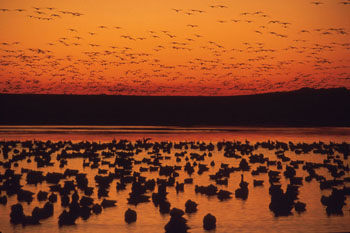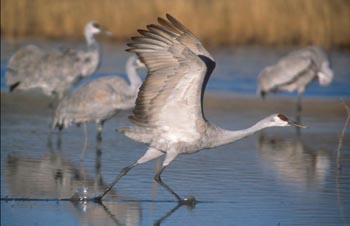Copyright © Andy Long
A sandhill crane takes to the air after its run on the water.
While many destinations need to use their full names to be recognized, there’s one spot that anyone who enjoys doing bird photography knows by a single word—“Bosque.” This wonderful New Mexico location–home to more than 50,000 snow geese and nearly 20,000 sandhill cranes every winter, as well as a variety of other waterfowl– is a must-see on any bird photographers’ trip list. The main flocks of geese and cranes arrive around the end of November and are gone by the middle of February, providing plenty of time to plan an adventure and capture great images. And “great” is a word that can’t be stressed enough. In fact, after you see the results you’ve collected following your first visit to Bosque del Apache National Wildlife Refuge , it’s likely you’ll return at least once and probably many more times.
The best way to describe Bosque is “WOW!” On my first sunrise visit to the refuge, the sight unfolding in front of my eyes had me mesmerized as thousands upon thousands of snow geese took to the air. It took me a second to realize I had a camera set up to capture the magical moment, and I had better begin shooting.
The sound of the birds’ take-off is just as astounding as the sight of all of them rising at the same time. Since my first visit to the refuge, which is located about a two-hour drive south of Albuquerque, I have been running workshops there each year and never tire of making the trek south from my home in the Denver, Colorado area.

Copyright © Andy Long
About 20 minutes before sunrise thousands
of snow geese converge on the main lake.
Shooting should actually begin well before the sun appears. About twenty minutes before sunrise, just as the eastern sky starts to turn a beautiful orange, thousands of snow geese – that have spent the night on outer ponds, rivers, and other water holes – gradually converge on the main lake in the refuge. (While the orange skies have been less frequent over the past several years, whatever color the sky offers provides a beautiful backdrop to the arriving birds.)
It’s during this time that shutters click away as photographers take shots of the mass arrival. Some choose blur images of individuals or small groups, while others choose sharp silhouettes of the birds against the sky. Once the flocks near the shore, their morning ritual of bathing and wing-flapping begins, creating even more photo opportunities. Usually right after sunrise and with no warning at all, the main event happens as all of the snow geese on the lake take off together to head to the fields for their daily feeding. Some will filter their way back to the lake for more swimming before their final departure to their feeding grounds.
All the while the exodus is going on, the sandhill cranes that have spent the night on the lake take their time lazily indulging in their morning preening before taking off to find their first feeding location, which may be the same spot the snow geese chose. Throughout the day, there’s a flurry of activity within the refuge due to a feeding management system. The refuge personnel have numerous fields set up to feed their winter guests. Multiple fields are prepared in order to keep the groups separated in case some type of disease comes through the area. If the groups aren’t crowded together, not all the birds will be afflicted. Whether the refuge cutting cycle has the birds close to the loop road or farther away from your shooting location will depend on when you visit.
Copyright © Andy Long
Flight shots are easy to get at the feeding fields.
A few years ago, the refuge built several ponds beyond the primary refuge area that are also good for early morning photography. While the main group of snow geese congregates at the lake, many birds use the outside pond. Happily, the geese that remain at the outside pond stay there longer than those leaving the main lake at sunrise, allowing photographers to shoot at the main pond before relocating to the outside pond for more opportunities.
My favorite morning activity at Bosque is photographing the sandhill cranes running on the water to take off. Being such large birds, they have to get a running start in order to initiate flight. They let you know when they’re going to do it by moving to the edges of the group and leaning forward to gain momentum. There are a couple of ponds on the road leading to the refuge on the west side of the road that are situated perfectly for capturing this behavior with the sun at your back. Attending with several photographers so that different people can watch different groups of cranes to let everyone know when a flock is preparing for lift-off is helpful.

Copyright © Andy Long
Sandhill crane running on the water in preparation to take off.
Morning flight shots of the cranes that spend the night on the main lake are primarily silhouette images of them in the sky. I’ve imagined a shot in the back of my mind (not in my camera yet) of a sandhill crane in flight right in front of a low sun, almost fully inside the circle. I’ve tried for several years to get this image, but I don’t have it yet, which means I’ll keep going back until I catch it just the way I want it.
No matter when you go during the winter gathering of the birds, you’re sure to be met by lots of other photographers and birders, especially on weekends. While the lake can be quite crowded for the morning “big show,” throughout the day and evening, there won’t be nearly as many people around. The main spot for feeding during the day (on the north loop road) will attract a number of photographers set up for individual flight shots of both the snow geese and sandhill cranes, but it won’t be so crowded that you won’t enjoy the action. It’s here that large lenses make for the best shots. While smaller telephotos can be used, the larger 400mm, 500mm and 600mm lenses help capture the best shots.
Copyright © Andy Long
Several spots allow for nice silhouette shots at sunset.
As evening approaches, the favorite images involve the sandhill cranes coming in to their favorite roosting ponds. Silhouette shots of them against a colorful sky are the main attraction. Several spots, including the main lake and the outside ponds, provide the best opportunity for these shots.
Another popular subject at Bosque is the extremely cooperative roadrunners. In the early morning, they come out of their roosting spots to warm up for a busy day of chasing around for a meal. They turn their backs to the sun and puff up their feathers to let the sun’s rays heat them. If you find a single roadrunner that is warming itself, you can often move quite close for some nice images.
With such a wide variety of subjects and frequent good weather, you may want to add Bosque to your regularly scheduled destinations. When you become a regular winter visitor, be sure to say hi to the people you saw in the Bosque the year before, or the year before that, as you’ll see them year after year.
by Andy Long

Leave a Reply